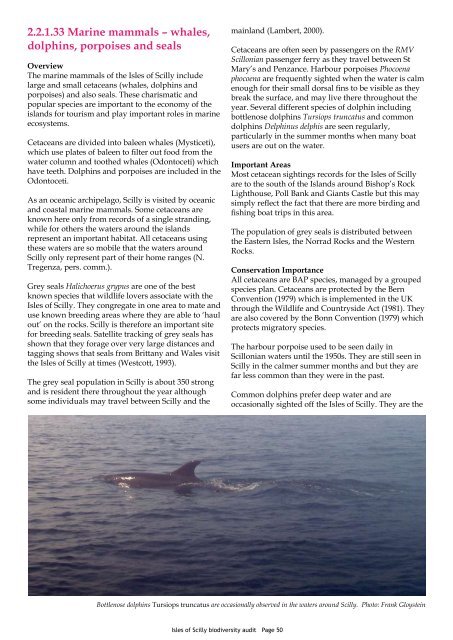The Isles of Scilly Biodiversity Audit 2008 - Cornwall Wildlife Trust
The Isles of Scilly Biodiversity Audit 2008 - Cornwall Wildlife Trust
The Isles of Scilly Biodiversity Audit 2008 - Cornwall Wildlife Trust
You also want an ePaper? Increase the reach of your titles
YUMPU automatically turns print PDFs into web optimized ePapers that Google loves.
2.2.1.33 Marine mammals – whales,dolphins, porpoises and sealsOverview<strong>The</strong> marine mammals <strong>of</strong> the <strong>Isles</strong> <strong>of</strong> <strong>Scilly</strong> includelarge and small cetaceans (whales, dolphins andporpoises) and also seals. <strong>The</strong>se charismatic andpopular species are important to the economy <strong>of</strong> theislands for tourism and play important roles in marineecosystems.Cetaceans are divided into baleen whales (Mysticeti),which use plates <strong>of</strong> baleen to filter out food from thewater column and toothed whales (Odontoceti) whichhave teeth. Dolphins and porpoises are included in theOdontoceti.As an oceanic archipelago, <strong>Scilly</strong> is visited by oceanicand coastal marine mammals. Some cetaceans areknown here only from records <strong>of</strong> a single stranding,while for others the waters around the islandsrepresent an important habitat. All cetaceans usingthese waters are so mobile that the waters around<strong>Scilly</strong> only represent part <strong>of</strong> their home ranges (N.Tregenza, pers. comm.).Grey seals Halichoerus grypus are one <strong>of</strong> the bestknown species that wildlife lovers associate with the<strong>Isles</strong> <strong>of</strong> <strong>Scilly</strong>. <strong>The</strong>y congregate in one area to mate anduse known breeding areas where they are able to ‘haulout’ on the rocks. <strong>Scilly</strong> is therefore an important sitefor breeding seals. Satellite tracking <strong>of</strong> grey seals hasshown that they forage over very large distances andtagging shows that seals from Brittany and Wales visitthe <strong>Isles</strong> <strong>of</strong> <strong>Scilly</strong> at times (Westcott, 1993).<strong>The</strong> grey seal population in <strong>Scilly</strong> is about 350 strongand is resident there throughout the year althoughsome individuals may travel between <strong>Scilly</strong> and themainland (Lambert, 2000).Cetaceans are <strong>of</strong>ten seen by passengers on the RMVScillonian passenger ferry as they travel between StMary’s and Penzance. Harbour porpoises Phocoenaphocoena are frequently sighted when the water is calmenough for their small dorsal fins to be visible as theybreak the surface, and may live there throughout theyear. Several different species <strong>of</strong> dolphin includingbottlenose dolphins Tursiops truncatus and commondolphins Delphinus delphis are seen regularly,particularly in the summer months when many boatusers are out on the water.Important AreasMost cetacean sightings records for the <strong>Isles</strong> <strong>of</strong> <strong>Scilly</strong>are to the south <strong>of</strong> the Islands around Bishop’s RockLighthouse, Poll Bank and Giants Castle but this maysimply reflect the fact that there are more birding andfishing boat trips in this area.<strong>The</strong> population <strong>of</strong> grey seals is distributed betweenthe Eastern <strong>Isles</strong>, the Norrad Rocks and the WesternRocks.Conservation ImportanceAll cetaceans are BAP species, managed by a groupedspecies plan. Cetaceans are protected by the BernConvention (1979) which is implemented in the UKthrough the <strong>Wildlife</strong> and Countryside Act (1981). <strong>The</strong>yare also covered by the Bonn Convention (1979) whichprotects migratory species.<strong>The</strong> harbour porpoise used to be seen daily inScillonian waters until the 1950s. <strong>The</strong>y are still seen in<strong>Scilly</strong> in the calmer summer months and but they arefar less common than they were in the past.Common dolphins prefer deep water and areoccasionally sighted <strong>of</strong>f the <strong>Isles</strong> <strong>of</strong> <strong>Scilly</strong>. <strong>The</strong>y are theBottlenose dolphins Tursiops truncatus are occasionally observed in the waters around <strong>Scilly</strong>. Photo: Frank Gloystein<strong>Isles</strong> <strong>of</strong> <strong>Scilly</strong> biodiversity audit Page 50
















